Abstract
Semiconductor-based photocatalysis is a probable approach to overcoming many pollution problems and eradicating toxic organic materials from wastewater. This research endeavor aimed to explore the synergistic potential of different semiconductor nanocomposites for photocatalytic degradation of organic pollutants in contaminated water. A facile hydrothermal approach was employed to synthesize bismuth oxide and cobalt ferrite nanoparticles from their precursors—bismuth nitrate pentahydrate, ferric chloride hexahydrate and cobalt chloride hexahydrate—with various concentrations and conditions to optimize the product. Subsequently, nanocomposites of bismuth oxide and cobalt ferrite were prepared by solid-state mixing in varying concentrations followed by calcination. UV/visible diffuse reflectance spectroscopy, X-ray diffraction, scanning electron microscopy and elemental dispersive X-ray spectroscopic techniques have corroborated the successful synthesis of nanocomposites. The energy gaps of bismuth oxide and cobalt ferrite nanocomposites were computed in the range of 1.58–1.62 eV by Tauc plots. These nanocomposite materials were ascertained for photocatalytic potential to degrade methyl orange organic dye in water. A nanocomposite with equiquantic proportions has shown the best photocatalytic degradation activity, which may be attributed to the type-II band configuration and a synergistic effect, because Bi2O3 acts as an electron sink. This synergism has reduced the cogent band gap, hindered electron hole recombination and increased electron hole availabilities for photodegradation reactions, thus ensuing an efficient photodegradation co-work of Bi2O3/CoFe2O4 nanocomposites.
1. Introduction
Water pollution is a major environmental problem worldwide. Wastewater contains numerous hazardous and toxic substances such as dyes, resins, heavy metals, phenolic compounds, pesticides and herbicides etc. [1,2,3]. Dye pollutants are carcinogenic and mutagenic; they can lead to central nervous system dysfunction and may cause morbidity in human as well as in aquatic life [4,5]. Conventional wastewater treatment pathways are not effective because of the contumacious nature of synthetic dyes and the high salinity of wastewater [6,7]. Ozonation and chlorination are also quite incapable because of their high operating costs [8,9]. The conventional physical methods, such as adsorption via activated carbon, ion exchange through synthetic adsorbent resins, reverse osmosis, ultrafiltration, coagulation by chemical agents etc., have been employed for the removal of toxic dyes from water [10,11]. These procedures are successful for transferring organic pollutants from water to another form, thereby producing secondary pollution which needs more treatment for removal of solid wastes and regeneration of the adsorbent and, thus, raises the cost of the process [12,13,14]. Among these contaminants, dyes, phenolics and pesticides have been of major concern because of their harmfulness to the environment. Advanced oxidation processes have potential for the removal of water polluted with hard degradable organic compounds. Moreover, hybrid processes combining membrane separation and heterogeneous photocatalysis, called photocatalytic membrane reactors, offer an amazing solution by complementing the advantages and overcoming the challenges of each other.
Photocatalytic oxidation involves advanced oxidation techniques for the degradation of dyes and many other toxic organic pollutants [15,16,17]. Nowadays, semiconductors are used as photocatalysts as they are cost-effective and have furnished good results. The most effective photocatalysts found in the literature are selenides, sulfides, metal oxides and the compounds with a modest band gap energy of 1.1–3.8 eV, such as TiO2, ZnO and WO3. However, these metal sulfides and selenides have issues, such as instability, photo anodic corrosion and toxicity [18,19,20,21,22].
Recently, cobalt ferrite has hugely attracted researchers for its utilization in photocatalytic wastewater treatment [23,24,25,26,27,28,29]. CoFe2O4 and its composites are low-cost and possess extraordinary magnetic properties, which results in higher adsorption ability as compared to other photocatalysts. Their photocatalytic activity improves owing to their narrow band gap, rapid transfer capability for charge carriers, higher visible light response, chemical functionalities, morphologies and annealing temperature. Dutta et al. reviewed the photocatalytic activity of CoFe2O4 against noxious organic pollutants in water and pointed out its limitations, such as aggregation, the recombination rate of electron holes and photocorrosion [25]. Their study concluded that the formation of CoFe2O4-based heterojunctions is seemingly acceptable for the improved photocatalytic performance, because the combination of CoFe2O4 with other photocatalysts that have various band gap positions would exhibit synergistic effects, which permits more pollutant compounds to be accessible for photodegradation and enhances the rate of charge separation, thus reducing electron hole recombination. Habibi and Parhizkar prepared spinel phase CoFe2O4 nanocomposites through a hydrothermal method using CoFe2O4 and iron nitrate as precursors and ethylene glycol as a chelating agent [26]. Their product has demonstrated an energy gap of 1.3 eV and 68.0% breakdown of Reactive Red 4 (azo dye) within 100 min. They mainly attribute this enhanced activity to the shift of electrons and holes to the surface of nanocomposites, which hinders electron hole recombination. Cubic ferro spinel nanostructures of Co0.2Zn0.8Fe2O4 were prepared by A. Boudjemaa et al. via coprecipitation [23]. These structures were n-type semiconductors with a lower band gap which dramatically enhanced photocatalytic activity under visible light irradiation. Z. Yamani studied photocatalytic degradation performance of magnetically separable CoFe2O4/BiOCl composites against Rhodamine B under UV light irradiation [29]. Yamani concluded that the adsorption of RhB molecules was favored on the surface, caused by the development of heterojunctions on the interface between BiOCl and ferrites. Y. Deng et al. successfully synthesized a recyclable photo-Fenton catalyst, of composition CoFe2O4@polypyrrole, by simple in situ Fenton oxidization polymerization [24]. This catalyst system has exhibited 90% discoloration in up to five cycles against methyl orange, methylene blue and rhodamine B. The degradation measurement in the presence of reactive species scavengers has revealed that the holes and the hydroxyl radical were the major reactive oxygen species in the CoFe2O4@PPy system. Y. Deng et al. has attributed this performance enhancement to the combination of enhanced Fenton response by coordinated PPy and Fe2+ redox pairs and photocatalytic performance by improved photo-led charge separation and adsorption. A boost in catalytic performance of pristine CoFe2O4 was observed by R. Sharma when yttrium was doped into a cobalt ferrite single-phase cubic spinel structure [27]. This increased BET surface area values and a reduced band gap. The good recyclability of prepared photocatalysts has proven the good stability of the materials used in wastewater treatment. A CoFe2O4/PMS (peroxymonosulphate) system, prepared by sol-gel combustion method, has demonstrated good photodegradation of methyl orange and phenol [28]. Surface hydroxyls of Co2+/PMS have played a significant role in the generation of sulphate and hydroxyl free radicals in neutral medium, producing more surface active sites.
Among numerous semiconductors, Bi2O3 and CoFe2O4 are potent candidates for photoactive nanocomposite preparations due to their distinctive structures and physical aspects, such as band gap, thermal stability, high oxygen ion conductivity and high refractive index. However, bare Bi2O3 and CoFe2O4 show less photo catalytic activity, owing to photo corrosion, rapid charge carrier recombination and structural conversions [30,31,32,33]. Different methods can be utilized to increase the photocatalytic activity of Bi2O3 and CoFe2O4, such as doping of transition metal oxides or rare earth metals and formation of nanocomposites in order to sensitize the photocatalyst to photo energy and to keep electron hole pairs separate. One of the most efficient ways to resolve this issue is to prepare nanocomposites of compatible semiconductor materials with a synergistic effect that will help charge migration [34,35,36,37,38,39,40,41,42,43,44,45,46,47].
The present study has explored the compatibility of Bi2O3 and CoFe2O4 for the preparation of photoactive nanocomposites with good photodegradation potential against methyl orange dye. To our knowledge, no earlier research has been reported in the literature regarding the synthesis of Bi2O3/CoFe2O4 nanocomposites and their dye degradation potential.
2. Results
This study aimed to develop different nanocomposites of bismuth oxide and cobalt ferrite semiconductor materials that work synergistically to improve photocatalytic activity for efficient photodegradation of methyl orange dye. As-prepared nanocomposite materials were characterized by X-ray diffraction (XRD), scanning electron microscopy (SEM) and energy dispersive X-ray (EDX) spectroscopic techniques while their energy gaps were gauged by UV/Vis diffuse reflectance spectroscopy (DRS) via Tauc plots. Photodegradation experiment results were employed to study photocatalytic efficiency.
2.1. Phase Analysis
XRD patterns of prepared samples were scanned in the range of 10° to 70° by X-ray diffractometer (D8 advance, BRUKER, Camarillo, CA, USA) with Cu-Kα radiation (k = 1.5406 Å) at room temperature. All the peaks in Figure 1a were found to be consistent with the available standard JCPDS 01-077-0426 and can be indexed to a single-phase cubic CoFe2O4 structure. Reflection (220), exhibited at 30.12° exclusively, depends on the Co2+ cations occupying the cubic sites. No additional and intermediate phases were observed within the sensitivity of the experimental measurements. The crystallite size of as-prepared CoFe2O4 particles was computed by the classical Scherrer formula [48]. Dhkl = kλ/βcosθ, where Dhkl is the crystallite size derived from the (311) peak of the XRD spectrum, k the sphere shape factor (0.89), θ the angle of diffraction, β the difference between the full width at half-maximum (FWHM) of the sample peak and the standard SiO2 used to calibrate the intrinsic width associated with the instruments and λ the X-ray wavelength (1.5406 Å). The obtained crystallite size of as-prepared CoFe2O4 particles was about 26.6 nm (Table 1). The XRD pattern of Bi2O3 (Figure 1e) was in agreement with the available standard JCPDS 00-022-0515. The crystal system of Bi2O3 was a tetragonal form which is a metastable two-dimensional superstructure of β-Bi2O3 [49]. Diffraction lines of Bi2O3 patterns have indicated that the powder has a good degree of crystallinity (Figure 1e). The crystallite size of Bi2O3 was computed from the full width at half-maximum intensity of the (201) X-ray line diffraction and was found to be approximately 32 nm.
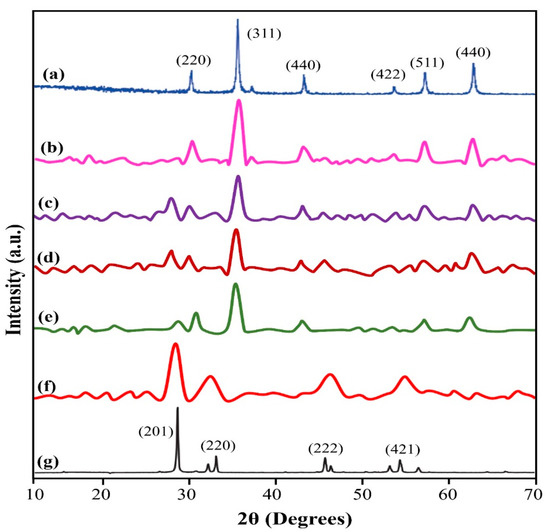
Figure 1.
XRD patterns of (a) CoFe2O4 [32]; (b) CoFe2O4 (as-prepared); (c) NC-3; (d) NC-2; (e) NC-1; (f) Bi2O3 (as-prepared); (g) Bi2O3 [43].

Table 1.
Crystallite size of prepared samples.
With the increase in Bi2O3 content in Bi2O3/CoFe2O4 nanocomposites, the intensity of the (201) peak at 27.42°, which is identified as the main peak of the Bi2O3 phase, gradually increased, whereas that of the (311) peak at 35.16°, inherent from the CoFe2O4 phase, was decreased. It was evident from Figure 1b–d that individual peaks of Bi2O3 and CoFe2O4 varied directly with their proportions in as-prepared nanocomposite materials, thus depicting no chemical reaction between the constituent chemicals. Furthermore, the purity of the samples is also apparent from the lack of any extra peak in the diffraction patterns of all prepared photocatalysts.
2.2. Elemental Analysis
EDX analysis was performed by a VEGA3 machine (TESCAN, Kohoutovice, Czech Republic) to determine the elemental composition of prepared samples. Each element showed its specific peaks in the graph, signifying its quantified presence in the sample. All peaks corresponded to CoFe2O4 with no extra peak showing the purity of the sample. The spectrum depicted signals of cobalt, iron and oxygen with 17.43%, 30.48% and 52.09% by weight, respectively. The composition, determined by energy-dispersive spectroscopy, showed the stoichiometry of CoFe2O4. Since the atomic numbers of cobalt and iron are closer, the ratio of the X-ray intensities from these elements generally associated with their composition. The intensity ratio of Co:Fe was about 1:2, as determined by the EDX. In this case, X-ray intensities do not need to be compensated for absorption and fluorescence effects, as these particles are smaller than the free path required for X-ray transmission through solids, i.e., 100 nm. The EDX pattern of Bi2O3 has shown no extra peak, which indicates that the sample was pure. The spectrum has shown signals of O and Bi with 23.06% and 76.94% by weight, respectively (Table 2).

Table 2.
EDX elemental data of as-prepared samples.
Qualitative and quantitative EDX results from the nanocomposites agreed with as-prepared compositions, which indicates that no element was lost due to any volatile product formation by heating during nanocomposite calcination.
2.3. Morphological Analysis
A field-emission scanning electron microscope (VEGA3 TESCAN) was used for morphological studies of as-prepared Bi2O3, CoFe2O4 and their nanocomposites. SEM micrographs (Figure 2a–e) were recorded at 200 and 500 nm scales to examine the morphology of the prepared materials. The textures of pure CoFe2O4 and Bi2O3 were observed as granular nanoparticles (Figure 2a,b).
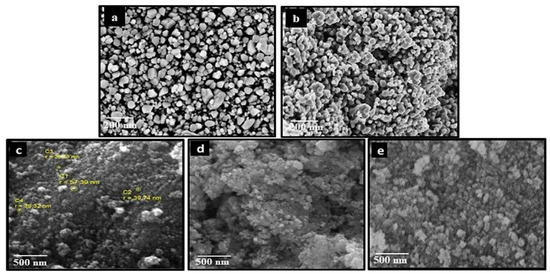
Figure 2.
SEM images of (a) Bi2O3; (b) CoFe2O4; (c) NC-1; (d) NC-2; (e) NC-3.
Scanning electron micrographs of as-prepared nanocomposites have shown irregular granular microstructures with slight agglomeration despite the dipolar interaction between the particles. For compositional uniformity from particle to particle, it was demonstrated that both Bi2O3 and CoFe2O4 phases were positioned on the grain surface side-by-side. Hence, the prepared Bi2O3/CoFe2O4 nanocomposites were considered to be a tightly contacting heterojunction structure between Bi2O3 and CoFe2O4, formed in nano-size level. SEM images of the Bi2O3/CoFe2O4 nanocomposites have shown no significant change in the morphology of the constituent nanoparticles. However, it was established that as Bi2O3 contents were increased, the grains in the nanocomposite matrix became larger and more agglomerated, while the shape of the grains was not changed (Figure 2c–e). SEM micrographs have shown that the average particle size of prepared nanoparticles and their composites was below 100 nm, which was also in agreement with those computed from the X-ray powder diffraction peaks.
2.4. Diffuse Reflectance Spectroscopy and Tauc Plots
DRS spectra were employed to construct Tauc plots of the prepared catalysts. Tauc plots were plotted between photon energy and (αhν)2 to calculate band gaps. Bi2O3 has shown a single hump at 521 nm. Extrapolation of the linear region of the Tauc plot (inset Figure 3a) has furnished a band gap of 2.55 eV for hydrothermally prepared Bi2O3. CoFe2O4 has an intrinsic black color, so it has shown absorption in a wide range of wavelengths [50]. The absorption spectra of cobalt ferrite exhibited a single hump at 751 nm. As cobalt ferrite is a direct semiconductor, the band gap value was 1.63 eV, computed from the Tauc plot (inset Figure 3b). The band gaps of the nanocomposites, namely NC-1, NC-2 and NC-3, were calculated as 1.62, 1.58 and 1.61 eV, respectively, by Tauc plots (inset Figure 3c–e). For the Bi2O3/CoFe2O4 nanocomposites, absorbance reduced as the loading of Bi2O3 increased. However, those values of absorbance could be useful in predicting the relative amount of CoFe2O4 and Bi2O3 in the synthesized composites by using the Beer–Lambert law.
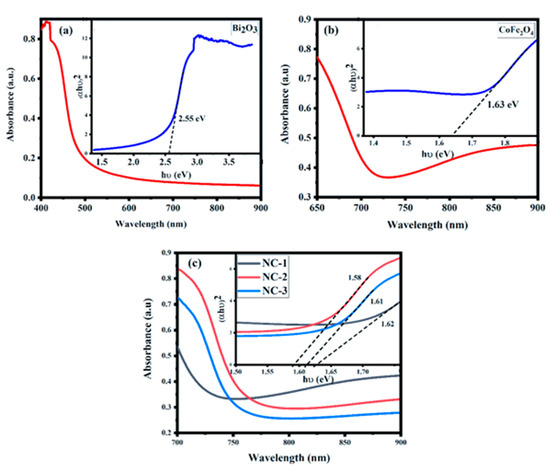
Figure 3.
DRS spectra and Tauc plots of (a) Bi2O3; (b) CoFe2O4; (c) NC-1, NC-2, NC-3.
2.5. Photodegradation Activity
The degradation of methyl orange dye was studied by logging changes in the absorption value of a charged dye solution at its λmax ≈ 462 nm for different hourly time intervals of a light irradiation experiment (Table 3). Figure 4 shows degradation spectra of methyl orange for each prepared catalyst along with a blank sample. The photodegradation activities of all prepared nanocatalysts were plotted in terms of percentage degradation versus passage of time (Figure 5). NC-1 (1:3 Bi2O3/CoFe2O4) has also shown good degradation results. It degraded up to 82% of the dye in 5 h of light exposure. NC-2 (1:1 Bi2O3/CoFe2O4) has shown the best degradation results. It degraded up to 92% of the dye in 5 h of the light irradiation experiment, as evidenced from the associated absorbance spectra taken during photocatalytic bleaching. NC-3 (3:1 Bi2O3/CoFe2O4) has shown moderate degradation results. It degraded up to 78% of the dye in 5 h of light illumination (Figure 6). These results have shown that all prepared nanocomposites exhibited good photodegradation activities as compared to bare materials. The blank with no nanocatalyst has exhibited a minimal decrease, i.e., about 2%, in absorbance when subjected to light irradiation for the period of 5 h witnessed in Figure 4. This shows an evident synergism phenomenon operating between the constituents of the nanocomposites.

Table 3.
Absorbance values of dye solutions charged by various as-prepared photocatalysts during photodegradation experiment in comparison to blank.
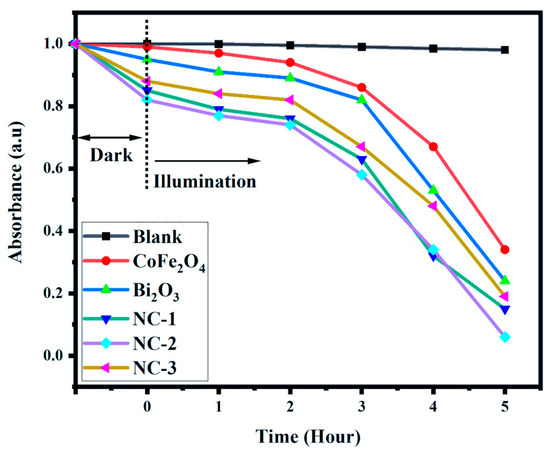
Figure 4.
Absorbance of dye solutions charged by various as-prepared photocatalysts during photodegradation experiment.
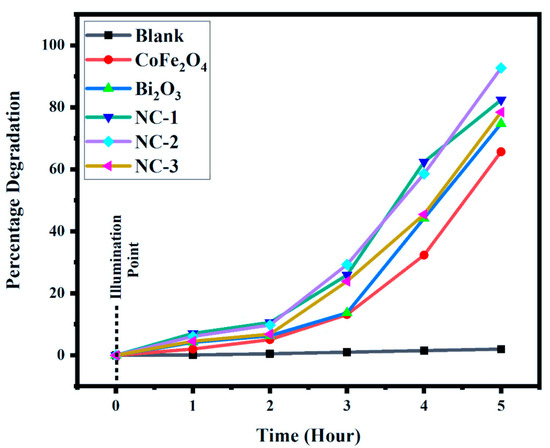
Figure 5.
Photodegradation activities of as-prepared photocatalysts against methyl orange dye solution.
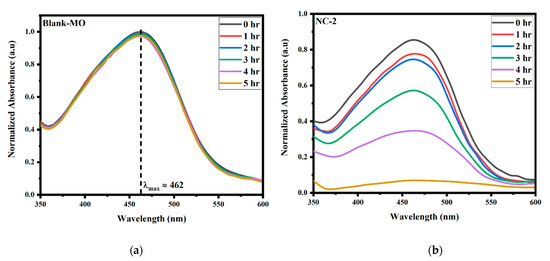
Figure 6.
UV/visible spectral information for (a) Blank and (b) NC-2 under illumination.
Photodegradation efficiency of all prepared catalysts against methyl orange was calculated by the formula:
where Ao is absorbance at time 0 min and At is absorbance after time “t” min of the photodegradation experiment. Ao and At were recorded at λmax of the dye [51]. Figure 7 shows the comparison of the percentage efficiency of all prepared catalysts against methyl orange. The highest efficiency was calculated for NC-2, which is due to the optimum constitution of Bi2O3 and CoFe2O4 (1:1) as well as the effective migration of exciton pairs in the type-II band configuration between the constituent materials, resulting in the suppression of charge recombination.
Percentage Efficiency = [(Ao − At)/Ao] × 100
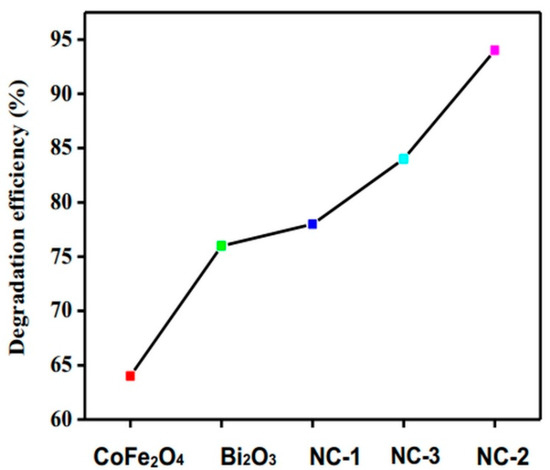
Figure 7.
Comparison of percentage efficiency of all prepared photocatalysts for methyl orange degradation.
2.6. Proposed Photodegradation Scheme
According to the aforementioned results, a speculative photocatalytic mechanism based on bibliographic data is proposed in Figure 8 [39,52,53,54]. Under continuous light irradiation, electrons become excited from valence bands of CoFe2O4 and Bi2O3 to their conduction bands, meanwhile producing holes in their respective valence bands. As both the valence band and conduction band of the CoFe2O4 are lower in energy than those of Bi2O3, cobalt ferrite acts as a light energy trapper. Subsequently, these electrons and holes are rearranged and enriched into the conduction band of Bi2O3 and the valence band of CoFe2O4, respectively. A band-to-band transition bridge is established between Bi2O3 and cobalt ferrite in which the energy levels are mismatched between each other. Since the conduction band potential of CoFe2O4 is more negative than that of Bi2O3, excited electrons are constantly shifted to the conduction band of Bi2O3. Meanwhile, as the valence band of CoFe2O4 is less positive than that of the Bi2O3, holes in the VB of Bi2O3 will transfer continuously to the VB of cobalt ferrite. This synergism will reduce the cogent band gap, hinder electron hole recombination and will increase electron hole availabilities for photodegradation reactions, thus ensuring efficient photodegradation co-work of Bi2O3/CoFe2O4 nanocomposites.
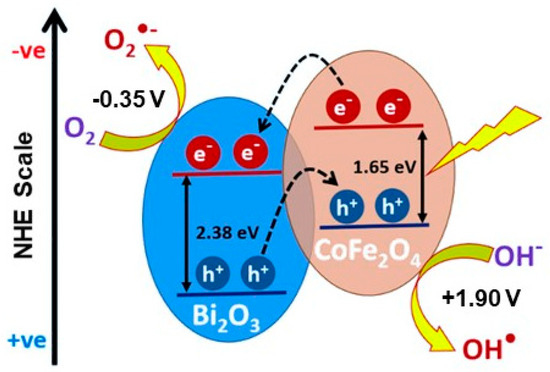
Figure 8.
Schematic illustration of energy level alignment and photodegradation action of Bi2O3/ CoFe2O4 nanocomposites.
These holes in the VB of cobalt ferrite will react to H2O/OH− and produce highly reactive OH• radicals to start the process of degradation. Simultaneously, electrons gathered in the conduction band of Bi2O3 react with adsorbed oxygen and form oxidants such as superoxide ions. These active species such as OH• and O2•− radicals react to degrade molecules of the dye into H2O, CO2 or other small molecular products. Chemical equations of this speculative photocatalytic mechanism based on bibliographic data are illustrated as:
CoFe2O4 + Bi2O3 + 2hν → CoFe2O4 (e− + h+) + Bi2O3 (e− + h+)
CoFe2O4 (e− + h+) + Bi2O3 (e− + h+) → CoFe2O4 (2h+) + Bi2O3 (2e−)
Bi2O3 (2e−) + 2O2 → 2O2•− + Bi2O3
CoFe2O4 (2h+) + 2OH− → CoFe2O4 + 2OH•
Dye + O2•− + OH• → CO2 + H2O + other by-product
The Bi2O3/CoFe2O4 heterojunction designed in this study is not similar to the type-I heterojunction structure. It is considered for the Bi2O3/CoFe2O4 that CoFe2O4 plays its role as the main photocatalyst, while the Bi2O3 works as a photosensitizer [14,55,56]. The VB edge of Bi2O3 is lower than that of CoFe2O4; hence, this system is a type-II heterojunction [57,58]. Since these heterojunctions are tightly bounded at the nanoscale, the hole transfers through the junction are efficacious. Furthermore, the CoFe2O4, working as the main photocatalyst, is found side-by-side in the Bi2O3/CoFe2O4 nanocomposite. Hence, formation of a heterojunction structure does not shield the active sites of catalysts.
3. Materials and Methods
All the materials, viz., bismuth (III) nitrate pentahydrate, cobalt chloride hexahydrate, ferric chloride hexahydrate, polyvinyl pyrrolidone (MW 40,000), sodium hydroxide, nitric acid and glycerol were purchased from Daejung, Korea and used without further purification. Ethanol and deionized water were used for washing and preparation of solutions. Various concentrations of precursor solution and conditions of reactions were explored for material synthesis based on reported methods. However, the following optimized methods proved to avoid agglomeration of individual products and composites.
3.1. Synthesis of Bi2O3 Nanoparticles
Bismuth nitrate pentahydrate (0.97 g) was dissolved in 10 mL of 1.12 M HNO3 along with vigorous stirring in order to avoid hydrolyzation of Bi3+ ions. Subsequently, 0.072 g of polyvinylpyrrolidone (PVP) was added as surfactant into the above mixture and stirred by manual stirring for about 15–20 min. Later, 4 M NaOH solution was gradually added with constant stirring until the pH of the solution turned basic (pH = 11) and white precipitates appeared. After stirring for 10 min, the resultant suspension was placed into a Teflon-lined autoclave (KH100, Guangzhou Aolantec, China) at 90 °C for 1 h. The suspension was allowed to cool at room temperature and its white color turned to yellow. The resultant yellow precipitates were centrifuged in a centrifuge (Hermle, Germany) and washed with distilled water/ethanol several times. The resultant product was dried in a vacuum oven (Memmert, Germany) for 2 h at 80 °C. This furnished yellow, solid particles of bismuth oxide which were ground into a fine powder. This powder was further calcined at 400 °C for 4 h [42,43].
3.2. Synthesis of CoFe2O4 Nanoparticles
Magnetic cobalt ferrite nanoparticles were prepared via a simple, one-pot hydrothermal process. An aqueous solution containing 4 mmol FeCl3·6H2O was mixed with 0.078 M glycerol (surfactant) under constant stirring. Afterward, 2 mmol CoCl2·6H2O solution was added slowly into the above mixture to prepare a uniform solution. Highly alkaline conditions (pH = 13) of the reaction mixture were maintained by dropwise addition of 6 M NaOH solution. This resulted in a brownish-black precipitate mixture. Subsequently, the reaction mixture was transferred into a Teflon-lined autoclave and kept in an oven for 6 h at 200 °C. The resultant suspension was centrifuged and washed with distilled water several times. Later, the precipitates were dried at 100 °C for 6 h in a vacuum oven. The resultant cobalt ferrite product was ground into a powder [44,45].
3.3. Synthesis of Bi2O3/CoFe2O4 Nanocomposites
A physical method was opted for in order to prepare the nanocomposites. This involved simple, solid-state mixing of already synthesized bismuth oxide and cobalt ferrite nanoparticles, followed by 3 h grinding via pestle and mortar. Resultant mixtures were calcined at 400 °C for 4 h. Three nanocomposites with different proportions of CoFe2O4 and Bi2O3 were prepared (Table 4).

Table 4.
Details of Bi2O3/CoFe2O4 nanocomposites.
3.4. Degradation Experiment
Photodegradation studies were carried out against methyl orange dye to explore the photocatalytic properties of as-prepared nanocomposites. A 300 W xenon arc lamp was used as the light source for degradation studies and to irradiate beakers charged with dye stock solution and catalyst. A stock solution of 30 ppm methyl orange dye was prepared in distilled water. For each photodegradation run, 50 mL stock solution was poured into beakers and 10 mg of each prepared catalyst nanocomposite was added into these separately. These solutions were kept in the dark with constant stirring for 2 h to attain adsorption–desorption equilibrium. Afterward, samples were kept in a photoreactor chamber and light was shone on the system. After different predetermined intervals of time, 5 mL of each solution was stripped out and centrifuged for 5 min at 10,000 rpm to let the catalyst settle down. The solutions obtained were examined by UV–visible spectrophotometer (UV/Vis Lambda 365, Perkin Elmer, Akron, OH, USA) to ascertain the residual dye contents in the solution in order to study the photocatalytic activity and the level of methyl orange degradation [46,47].
4. Conclusions
Bi2O3/CoFe2O4 photocatalysts were successfully prepared by a facile agitation and the influence of different proportions of constituents was also investigated systematically. The results of XRD, SEM, EDX and UV–visible DRS spectroscopy have corroborated the synthesis of nanocomposites without any further chemical reaction or by-products, nor any change in morphology of the constituent chemicals. Bi2O3/CoFe2O4 heterojunctions have shown a high efficiency for decomposing organic dye under light irradiation as compared to both of the individual components. Furthermore, Bi2O3/CoFe2O4 induced mineralization by utilizing the electrons and the holes that were enriched in the conduction band of Bi2O3 and the valence band of CoFe2O4, respectively. The results suggested that CoFe2O4 acts as the main photocatalyst, while Bi2O3 works as a photosensitizer. The nanocomposite with 1:1 Bi2O3/CoFe2O4 composition showed the highest photodegradation efficiency, i.e., 92% for the degradation of methyl orange dye. The superior photocatalytic performance of the nanocomposite may be credited to its type-II band configuration, which results in the suppression of charge recombination because Bi2O3 acts as an electron sink. As per our research, no prior study has been reported in the literature regarding the synthesis of a Bi2O3/CoFe2O4 nanocomposite and its dye degradation potential. Therefore, good photocatalytic degradation activities, demonstrated by these nanocomposites, for contaminated aqueous solutions make these materials a potent candidate to develop robust photocatalysts for practical applications in water decontamination technology. The Bi2O3/CoFe2O4 is environmentally friendly, the synthesis is simple, and, if it were scaled up, the manufacturing cost would be low. This also leaves scope for researchers to further explore its photocatalytic activities against other dye/drug pollutants and its water splitting potential.
Author Contributions
Conceptualization, A.B.N., A.M. and A.S.; methodology A.B.N., F.R. and S.A.; formal analysis, F.R. and A.S.; writing—original draft preparation A.B.N., A.S. and S.A.; writing—review and editing, A.M.; supervision, A.M. All authors have read and agreed to the published version of the manuscript.
Funding
This research received no external funding.
Acknowledgments
The authors are thankful to Institute of Environmental Sciences & Engineering, School of Chemical & Materials Engineering, U.S.–Pakistan Center for Advanced Studies in Energy of NUST and the National Centre for Physics of QAU for extending their technical support to this research work.
Conflicts of Interest
The authors declare no conflict of interest.
References
- Gao, Q.; Xu, J.; Bu, X.-H. Recent advances about metal–organic frameworks in the removal of pollutants from wastewater. Coord. Chem. Rev. 2019, 378, 17–31. [Google Scholar] [CrossRef]
- Chong, M.N.; Jin, B.; Chow, C.W.; Saint, C. Recent developments in photocatalytic water treatment technology: A review. Water Res. 2010, 44, 2997–3027. [Google Scholar] [CrossRef] [PubMed]
- Mohammed, R.R. Removal of heavy metals from wastewater using black tea waste. Arab. J. Sci. Eng. 2012, 37, 1505–1520. [Google Scholar] [CrossRef]
- Manaa, Z.; Chebli, D.; Bouguettoucha, A.; Atout, H.; Amrane, A. Low-Cost Photo-Fenton-Like Process for the Removal of Synthetic Dye in Aqueous Solution at Circumneutral pH. Arab. J. Sci. Eng. 2019, 44, 9859–9867. [Google Scholar] [CrossRef]
- Dellamatrice, P.M.; Silva-Stenico, M.E.; de Moraes, L.A.B.; Fiore, M.F.; Monteiro, R.T.R. Degradation of textile dyes by cyanobacteria. Braz. J. Microbiol. 2017, 48, 25–31. [Google Scholar] [CrossRef] [PubMed] [Green Version]
- Kooh, M.R.R.; Dahri, M.K.; Lim, L.B.; Lim, L.H. Batch adsorption studies on the removal of acid blue 25 from aqueous solution using Azolla pinnata and soya bean waste. Arab. J. Sci. Eng. 2016, 41, 2453–2464. [Google Scholar] [CrossRef]
- Gupta, V.K.; Ali, I.; Saleh, T.A.; Nayak, A.; Agarwal, S. Chemical treatment technologies for waste-water recycling—An overview. Rsc. Adv. 2012, 2, 6380–6388. [Google Scholar] [CrossRef]
- Esplugas, S.; Bila, D.M.; Krause, L.G.T.; Dezotti, M. Ozonation and advanced oxidation technologies to remove endocrine disrupting chemicals (EDCs) and pharmaceuticals and personal care products (PPCPs) in water effluents. J. Hazard. Mater. 2007, 149, 631–642. [Google Scholar] [CrossRef]
- Moo-Young, H.K. Pulp and paper effluent management. JSTOR 2007, 79, 1733–1741. [Google Scholar] [CrossRef]
- Maleš, L.; Fakin, D.; Bračič, M.; Gorgieva, S. Efficiency of Differently Processed Membranes Based on Cellulose as Cationic Dye Adsorbents. Nanomaterials 2020, 10, 642. [Google Scholar] [CrossRef] [Green Version]
- Gogate, P.R.; Pandit, A.B. A review of imperative technologies for wastewater treatment II: Hybrid methods. Adv. Environ. Res. 2004, 8, 553–597. [Google Scholar] [CrossRef]
- Rauwel, P.; Uhl, W.; Rauwel, E. Editorial for the Special Issue on ‘Application and Behavior of Nanomaterials in Water Treatment’; Multidisciplinary Digital Publishing Institute: Basel, Switzerland, 2019. [Google Scholar]
- Coleman, H.M.; Eggins, B.R.; Byrne, J.A.; Palmer, F.L.; King, E. Photocatalytic degradation of 17-β-oestradiol on immobilised TiO2. Appl. Catal. B Environ. 2000, 24, L1–L5. [Google Scholar] [CrossRef]
- Akpan, U.G.; Hameed, B.H. Parameters affecting the photocatalytic degradation of dyes using TiO2-based photocatalysts: A review. J. Hazard. Mater. 2009, 170, 520–529. [Google Scholar] [CrossRef]
- Chauhan, N.; Singh, V.; Kumar, S.; Dhiman, R. Influence of Nickel, Silver, and Sulphur Doping on the Photocatalytic Efficiency of Mesoporous ZnO Nanoparticles. Arab. J. Sci. Eng. 2020, 45, 249–259. [Google Scholar] [CrossRef]
- Kabra, K.; Chaudhary, R.; Sawhney, R.L. Treatment of hazardous organic and inorganic compounds through aqueous-phase photocatalysis: A review. Ind. Eng. Chem. Res. 2004, 43, 7683–7696. [Google Scholar] [CrossRef]
- Hoffmann, M.R.; Martin, S.T.; Choi, W.; Bahnemann, D.W. Environmental applications of semiconductor photocatalysis. Chem. Rev. 1995, 95, 69–96. [Google Scholar] [CrossRef]
- Ismail, N.J.; Othman, M.H.D.; Kamaludin, R.; Esham, M.I.M.; Ali, N.A.; Rahman, M.A.; Jaafar, J.; Bakar, S.A. Characterization of Bauxite as a Potential Natural Photocatalyst for Photodegradation of Textile Dye. Arab. J. Sci. Eng. 2019, 44, 10031–10040. [Google Scholar] [CrossRef]
- Khan, M.M.; Adil, S.F.; Al-Mayouf, A. Metal Oxides as Photocatalysts; Elsevier: Amsterdam, The Netherlands, 2015. [Google Scholar]
- Zhou, H.; Qu, Y.; Zeid, T.; Duan, X. Towards highly efficient photocatalysts using semiconductor nanoarchitectures. Energy Environ. Sci. 2012, 5, 6732–6743. [Google Scholar] [CrossRef]
- Saravanan, R.; Gupta, V.K.; Narayanan, V.; Stephen, A. Comparative study on photocatalytic activity of ZnO prepared by different methods. J. Mol. Liq. 2013, 181, 133–141. [Google Scholar] [CrossRef]
- Khan, M.M.; Ansari, S.A.; Pradhan, D.; Ansari, M.O.; Lee, J.; Cho, M.H. Band gap engineered TiO2 nanoparticles for visible light induced photoelectrochemical and photocatalytic studies. J. Mater. Chem. A 2014, 2, 637–644. [Google Scholar] [CrossRef]
- Boudjemaa, A.; Popescu, I.; Juzsakova, T.; Kebir, M.; Helaili, N.; Bachari, K.; Marcu, I.C. M-Substituted (M=Co, Ni and Cu) Zinc Ferrite Photo-Catalysts for Hydrogen Production by Water Photo-Reduction. Int. J. Hydrog. Energy 2016, 41, 11108–11118. [Google Scholar] [CrossRef]
- Deng, Y.; Zhao, X.; Luo, J.; Wang, Z.; Tang, J. Magnetic Recyclable CoFe2O4@ Ppy Prepared by in Situ Fenton Oxidization Polymerization with Advanced Photo-Fenton Performance. RSC Adv. Tang 2020, 10, 1858–1869. [Google Scholar] [CrossRef] [Green Version]
- Dutta, V.; Sheetal, S.; Pankaj, R.; Ahmad, H.B.; Vinod, K.G.; Pardeep, J. Review on Augmentation in Photocatalytic Activity of CoFe2O4 Via Heterojunction Formation for Photocatalysis of Organic Pollutants in Water. J. Saudi Chem. Soc. Singh 2019, 23, 1119–1136. [Google Scholar]
- Habibi, M.H.; Janan, J. Cobalt Ferrite Nano-Composite Coated on Glass by Doctor Blade Method for Photo-Catalytic Degradation of an Azo Textile Dye Reactive Red 4: Xrd, Fesem and Drs Investigations. Spectrochim. Acta Part A Mol. Parhizkar Biomol. Spectrosc. 2015, 150, 879–885. [Google Scholar] [CrossRef]
- Sharma, R.; Kumar, V.; Bansal, S.; Singhal, S. Boosting the Catalytic Performance of Pristine CoFe2O4 with Yttrium (Y3+) Inclusion in the Spinel Structure. Mater. Res. Bull. Singhal 2017, 90, 94–103. [Google Scholar] [CrossRef]
- Devi, L.G.; Srinivas, M. Hydrothermal synthesis of reduced graphene oxide-CoFe2O4 heteroarchitecture for high visible light photocatalytic activity: Exploration of efficiency, stability and mechanistic pathways. J. Environ. Chem. Eng. 2017, 5, 3243–3255. [Google Scholar] [CrossRef]
- Yamani, Z. Magnetic Properties and Photocatalytic Degradation Performance of MFe2O4 (M=Co, Ni)/Biocl Composites Catalysts under Uv Light Irradiation. Arab. J. Sci. Eng. 2018, 43, 383–388. [Google Scholar] [CrossRef]
- Fan, H.; Pan, S.; Teng, X.; Ye, C.; Li, G.; Zhang, L. δ-Bi2O3 thin films prepared by reactive sputtering: Fabrication and characterization. Thin Solid Film. 2006, 513, 142–147. [Google Scholar] [CrossRef]
- Shan, D.; Zhang, J.; Xue, H.-G.; Zhang, Y.-C.; Cosnier, S.; Ding, S.-N. Polycrystalline bismuth oxide films for development of amperometric biosensor for phenolic compounds. Biosens. Bioelectron. 2009, 24, 3671–3676. [Google Scholar] [CrossRef]
- Shafi, K.V.; Gedanken, A.; Prozorov, R.; Balogh, J. Sonochemical preparation and size-dependent properties of nanostructured CoFe2O4 particles. Chem. Mater. 1998, 10, 3445–3450. [Google Scholar] [CrossRef]
- Zi, Z.; Sun, Y.; Zhu, X.; Yang, Z.; Dai, J.; Song, W. Synthesis and magnetic properties of CoFe2O4 ferrite nanoparticles. J. Magn. Magn. Mater. 2009, 321, 1251–1255. [Google Scholar] [CrossRef]
- Ullah, I.; Ali, S.; Hanif, M.A.; Shahid, S.A. Nanoscience for environmental remediation: A review. Int. J. Chem. Biochem. Sci. 2012, 2, 60–77. [Google Scholar]
- Dong, F.; Guo, S.; Wang, H.; Li, X.; Wu, Z. Enhancement of the visible light photocatalytic activity of C-doped TiO2 nanomaterials prepared by a green synthetic approach. J. Phys. Chem. C 2011, 115, 13285–13292. [Google Scholar] [CrossRef]
- Narayana, R.L.; Matheswaran, M.; Aziz, A.A.; Saravanan, P. Photocatalytic decolourization of basic green dye by pure and Fe, Co doped TiO2 under daylight illumination. Desalination 2011, 269, 249–253. [Google Scholar] [CrossRef]
- Dippong, T.; Levei, E.A.; Deac, I.G.; Neag, E.; Cadar, O. Influence of Cu2+, Ni2+, and Zn2+ Ions Doping on the Structure, Morphology, and Magnetic Properties of Co-Ferrite Embedded in SiO2 Matrix Obtained by an Innovative Sol-Gel Route. Nanomaterials 2020, 10, 580. [Google Scholar] [CrossRef] [PubMed] [Green Version]
- Serpone, N.; Emeline, A. Semiconductor Photocatalysis-Past, Present, and Future Outlook; ACS Publications: Washington, DC, USA, 2012. [Google Scholar]
- Chen, S.; Hu, Y.; Ji, L.; Jiang, X.; Fu, X. Preparation and characterization of direct Z-scheme photocatalyst Bi2O3/NaNbO3 and its reaction mechanism. Appl. Surf. Sci. 2014, 292, 357–366. [Google Scholar] [CrossRef]
- Kang, I.-C.; Zhang, Q.; Yin, S.; Sato, T.; Saito, F. Improvement in photocatalytic activity of TiO2 under visible irradiation through addition of N-TiO2. Environ. Sci. Technol. 2008, 42, 3622–3626. [Google Scholar] [CrossRef] [PubMed]
- Bai, S.; Liu, H.; Sun, J.; Tian, Y.; Chen, S.; Song, J.; Luo, R.; Li, D.; Chen, A.; Liu, C.-C. Improvement of TiO2 photocatalytic properties under visible light by WO3/TiO2 and MoO3/TiO2 composites. Appl. Surf. Sci. 2015, 338, 61–68. [Google Scholar] [CrossRef]
- Oudghiri-Hassani, H.; Rakass, S.; Al Wadaani, F.T.; Al-Ghamdi, K.J.; Omer, A.; Messali, M.; Abboudi, M. Synthesis, characterization and photocatalytic activity of α-Bi2O3 nanoparticles. J. Taibah Univ. Sci. 2015, 9, 508–512. [Google Scholar] [CrossRef] [Green Version]
- Mallahi, M.; Shokuhfar, A.; Vaezi, M.; Esmaeilirad, A.; Mazinani, V. Synthesis and characterization of bismuth oxide nanoparticles via sol-gel method. AJER 2014, 3, 162–165. [Google Scholar]
- Cote, L.J.; Teja, A.S.; Wilkinson, A.P.; Zhang, Z.J. Continuous hydrothermal synthesis of CoFe2O4 nanoparticles. Fluid Phase Equilibria 2003, 210, 307–317. [Google Scholar] [CrossRef]
- Maaz, K.; Mumtaz, A.; Hasanain, S.; Ceylan, A. Synthesis and magnetic properties of cobalt ferrite (CoFe2O4) nanoparticles prepared by wet chemical route. J. Magn. Magn. Mater. 2007, 308, 289–295. [Google Scholar] [CrossRef] [Green Version]
- Li, Y.; Li, X.; Li, J.; Yin, J. Photocatalytic degradation of methyl orange by TiO2-coated activated carbon and kinetic study. Water Res. 2006, 40, 1119–1126. [Google Scholar] [CrossRef] [PubMed]
- Wang, C.; Wang, X.; Xu, B.-Q.; Zhao, J.; Mai, B.; Sheng, G.; Fu, J. Enhanced photocatalytic performance of nanosized coupled ZnO/SnO2 photocatalysts for methyl orange degradation. J. Photochem. Photobiol. A Chem. 2004, 168, 47–52. [Google Scholar] [CrossRef]
- Mendelson, M.I. Average grain size in polycrystalline ceramics. J. Am. Ceram. Soc. 1969, 52, 443–446. [Google Scholar] [CrossRef]
- Medernach, J.W.; Snyder, R.L. Powder diffraction patterns and structures of the bismuth oxides. J. Am. Ceram. Soc. 1978, 61, 494–497. [Google Scholar] [CrossRef]
- Khan, M.S.; Ashiq, M.N.; Ehsan, M.F.; He, T.; Ijaz, S. Controlled synthesis of cobalt telluride superstructures for the visible light photo-conversion of carbon dioxide into methane. Appl. Catal. A Gen. 2014, 487, 202–209. [Google Scholar] [CrossRef]
- Bera, K.K.; Majumdar, R.; Chakraborty, M.; Bhattacharya, S.K. Phase control synthesis of α, β and α/β Bi2O3 hetero-junction with enhanced and synergistic photocatalytic activity on degradation of toxic dye, Rhodamine-B under natural sunlight. J. Hazard. Mater. 2018, 352, 182–191. [Google Scholar] [CrossRef]
- Cong, Y.; Zhang, J.; Chen, F.; Anpo, M.; He, D. Preparation, photocatalytic activity, and mechanism of nano-TiO2 co-doped with nitrogen and iron (III). J. Phys. Chem. C 2007, 111, 10618–10623. [Google Scholar] [CrossRef]
- Huang, S.; Xu, Y.; Xie, M.; Xu, H.; He, M.; Xia, J.; Huang, L.; Li, H. Synthesis of magnetic CoFe2O4/g-C3N4 composite and its enhancement of photocatalytic ability under visible-light. Colloids Surf. A Physicochem. Eng. Asp. 2015, 478, 71–80. [Google Scholar] [CrossRef]
- Fu, J.; Tian, Y.; Chang, B.; Xi, F.; Dong, X. BiOBr–carbon nitride heterojunctions: Synthesis, enhanced activity and photocatalytic mechanism. J. Mater. Chem. 2012, 22, 21159–21166. [Google Scholar] [CrossRef]
- Konstantinou, I.K.; Albanis, T.A. TiO2-assisted photocatalytic degradation of azo dyes in aqueous solution: Kinetic and mechanistic investigations: A review. Appl. Catal. B Environ. 2004, 49, 1–14. [Google Scholar] [CrossRef]
- Thiruvenkatachari, R.; Vigneswaran, S.; Moon, I.S. A review on UV/TiO2 photocatalytic oxidation process (Journal Review). Korean J. Chem. Eng. 2008, 25, 64–72. [Google Scholar] [CrossRef]
- He, G.; Ding, J.; Zhang, J.; Hao, Q.; Chen, H. One-step ball-milling preparation of highly photocatalytic active CoFe2O4–reduced graphene oxide heterojunctions for organic dye removal. Ind. Eng. Chem. Res. 2015, 54, 2862–2867. [Google Scholar] [CrossRef]
- Kumar, A.; Kumar, A.; Sharma, G.; Ala’a, H.; Naushad, M.; Ghfar, A.A.; Guo, C.; Stadler, F.J. Biochar-templated g-C3N4/Bi2O2CO3/CoFe2O4 nano-assembly for visible and solar assisted photo-degradation of paraquat, nitrophenol reduction and CO2 conversion. Chem. Eng. J. 2018, 339, 393–410. [Google Scholar] [CrossRef]
Publisher’s Note: MDPI stays neutral with regard to jurisdictional claims in published maps and institutional affiliations. |
© 2021 by the authors. Licensee MDPI, Basel, Switzerland. This article is an open access article distributed under the terms and conditions of the Creative Commons Attribution (CC BY) license (https://creativecommons.org/licenses/by/4.0/).